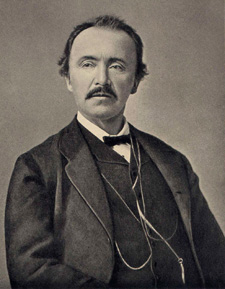

THE QUEST


Heinrich Schliemann ca. 1875 and his wife, Sophie Schliemann, wearing the "Jewels of Helen" from the so-called "Priam's Treasure"
If you believe that Troy existed the question is then where was Troy located? Tradition says the city was completely sacked;
if nothing remained of the city to find could anyone locate it?
The Greek tradition places Troy somewhere on the Troad Peninsula South of the Dardanelles in the North of the Aegean Sea . This place fits with Homer's description “the islands of Imbros, Samothrace and little Tenedos, Mount Ida to the south-east, the plain itself and the river Scamander which flowed down through the foothills of Ida.” But where exactly on that Peninsula did Troy lay?

After the Greeks colonized the Troad the Greek city Ilion claimed to be built upon the site of the original Troy . The Ilians firmly believed that their city was where Troy had been, and also claimed descent from the royal Trojan linage through the son of Hector, who they claim founded their city. The Ilians felt a close connection to the legendary city they claimed to be built on, even going so far as to refuse to worship Heracles because tradition associated him with an earlier sacking of Troy .
Was Ilion built on Troy ? Many ancients believed so including Alexander the Great who traveled there. While in Ilion Alexander the Great dedicated his armor in the temple of Athena , and took new armor supposedly from the Trojan War. By Roman times Ilion was becoming derelict, but still claimed by many to be the site of Troy . In 48 BCE Julius Caesar visited the site but according to Lucan in Pharsalia “etiam periere ruinae” even the ruins were destroyed.
More modern searches for Troy have also been done on the Troad. Archaeologist had excavated numerous places, and many claimed to have found Troy , though none had proof. In the 1860s a man named Frank Calvert put forth the theory that Troy had been located on a site called Hisarlik “the place of the fort.” Though Frank Calvert first said Troy was on Hisarlik and first started excavating the site it was Heinrich Schliemann who stole his glory and in the 1870s claimed to have found the remains of Troy .
Hisarlik is a stratified area with remains of numerous cities on top of each other. Schliemann tired to separate out the layers into various time periods and cities, which he called Troy I to Troy VII, with Troy VI being the city Homer described. In May of 1873 he found what he considered final proof that this site had once been Troy , the “Treasure of Priam” and the “Jewels of Helen.” He had uncovered gold jewelry as well as other bronze, silver and gold items, which he claimed were left by the fleeing Trojans. Despite rumors that these items were planted there Schliemann became famous for finding Troy and today archaeologists are still excavating Hisarlik, but was this really Homer's Troy?
The remains that archaeologist have uncovered in Hisarlik are those of a city, one that existed from ca. 3000 to 1000 BCE in fact. But is this city the Troy Homer wrote about? There are no sources to verify that this town is the Troy from Homer's Iliad, except the poem itself and from that the exact location of Troy is uncertain. Even if this city is Troy there is no proof that there was a Trojan War, or that it was anything other than a city a poet once described in a work of fiction. As excavations continue more is being learned about Troy and perhaps one day we will be able to identify this place as the site of that famous city, but until then no one can know for sure where Troy stood, if it existed at all.
Erskine, Andrew. "Torjan Past and Present," in Troy between Greece and Rome : Local, Tradition and Imperial Power . Great Britain : Oxford University Press, 2001.
Latacz, Joachim. Trans. Kevin Windle and Rosh Ireland . Troy and Homer: Towards a Solution of an Old Myster y . Oxford , Oxford University Press, 2004.
Wood, Michael. In Search of the Trojan War . London , Penguin Books, 1996.
Pictures from the Archaeological Institute of America (Salem Society) c/o Willamette University 900 State Street Salem, OR 97301-3922 http://www.willamette.edu/~anicgors/salemaia/